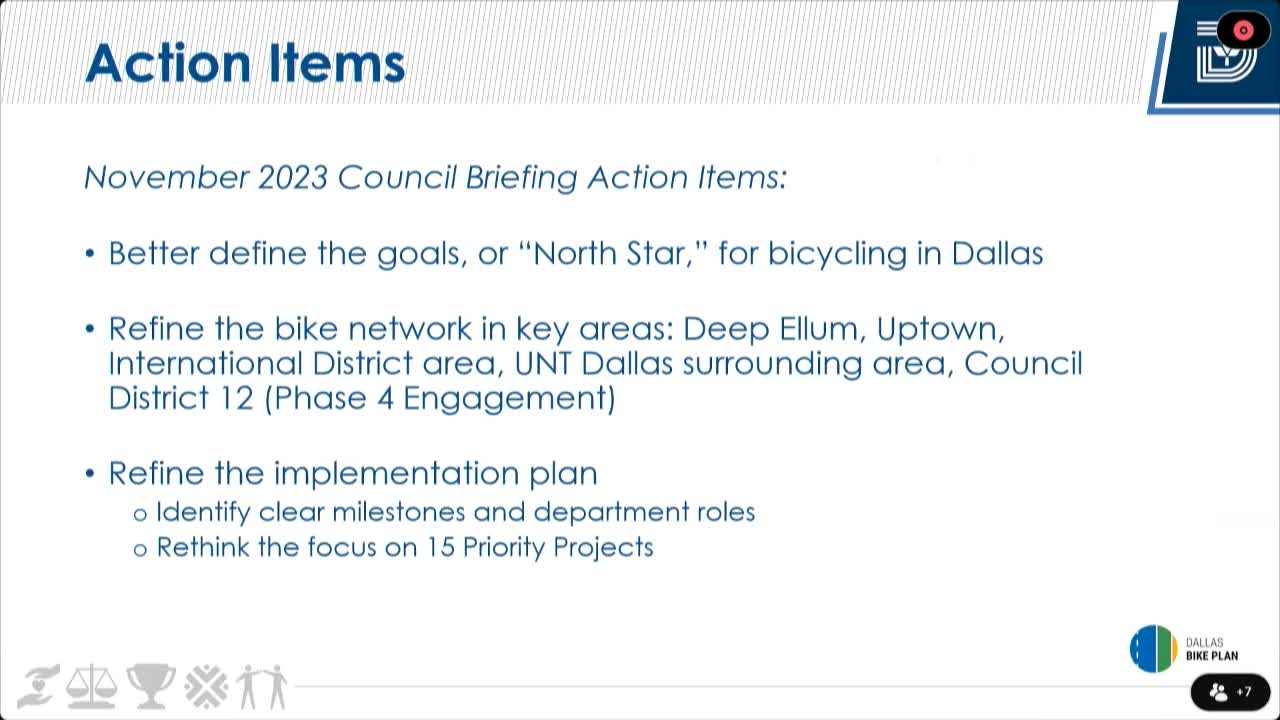City plans ambitious bike network for all ages and abilities
October 21, 2024 | Dallas, Dallas County, Texas
This article was created by AI summarizing key points discussed. AI makes mistakes, so for full details and context, please refer to the video of the full meeting. Please report any errors so we can fix them. Report an error »

In a recent government meeting, city officials discussed the ongoing development of a comprehensive bicycle network plan for Dallas, emphasizing the importance of creating a multimodal transportation system accessible to all ages and abilities. The meeting highlighted the city's commitment to enhancing bicycle infrastructure, which is part of a broader strategy to promote sustainable transportation options.
Since 2022, the city has engaged in four rounds of public consultation to refine its approach, moving from an initial focus on 15 priority projects to a more comprehensive plan that includes additional community input. The final phase of engagement is set to take place soon, allowing residents to provide feedback on the revised draft before it is presented to the city council for potential adoption.
The vision for Dallas's bicycle network aims to increase the number of short trips made by bicycle or micromobility devices, such as scooters. Officials outlined several key goals to achieve this vision, including the construction of a safe and comfortable bicycle network, ongoing maintenance of existing facilities, and equitable implementation of bike infrastructure across the city.
The implementation plan is divided into three phases. Phase 1, expected to run from 2025 to 2030, will focus on projects that are already funded and some lower-cost initiatives. Phase 2 will encompass a broader range of high-scoring, unfunded projects projected to cost up to $300 million over the next 20 years. This phase aims to enhance the network significantly, with funding anticipated from general fund commitments, grants, and future bond programs.
The prioritization of projects will be guided by factors such as safety, equity, public demand, and existing conditions, ensuring that the most impactful initiatives are addressed first. Additionally, the meeting touched on strategies for maintenance and potential future programs, such as an e-bike rebate initiative, to further support the city's cycling goals.
As Dallas moves forward with its bicycle network plan, officials remain focused on fostering a transportation environment that encourages cycling as a viable option for residents, ultimately contributing to the city's environmental and climate action objectives.
Since 2022, the city has engaged in four rounds of public consultation to refine its approach, moving from an initial focus on 15 priority projects to a more comprehensive plan that includes additional community input. The final phase of engagement is set to take place soon, allowing residents to provide feedback on the revised draft before it is presented to the city council for potential adoption.
The vision for Dallas's bicycle network aims to increase the number of short trips made by bicycle or micromobility devices, such as scooters. Officials outlined several key goals to achieve this vision, including the construction of a safe and comfortable bicycle network, ongoing maintenance of existing facilities, and equitable implementation of bike infrastructure across the city.
The implementation plan is divided into three phases. Phase 1, expected to run from 2025 to 2030, will focus on projects that are already funded and some lower-cost initiatives. Phase 2 will encompass a broader range of high-scoring, unfunded projects projected to cost up to $300 million over the next 20 years. This phase aims to enhance the network significantly, with funding anticipated from general fund commitments, grants, and future bond programs.
The prioritization of projects will be guided by factors such as safety, equity, public demand, and existing conditions, ensuring that the most impactful initiatives are addressed first. Additionally, the meeting touched on strategies for maintenance and potential future programs, such as an e-bike rebate initiative, to further support the city's cycling goals.
As Dallas moves forward with its bicycle network plan, officials remain focused on fostering a transportation environment that encourages cycling as a viable option for residents, ultimately contributing to the city's environmental and climate action objectives.
View full meeting
This article is based on a recent meeting—watch the full video and explore the complete transcript for deeper insights into the discussion.
View full meeting
